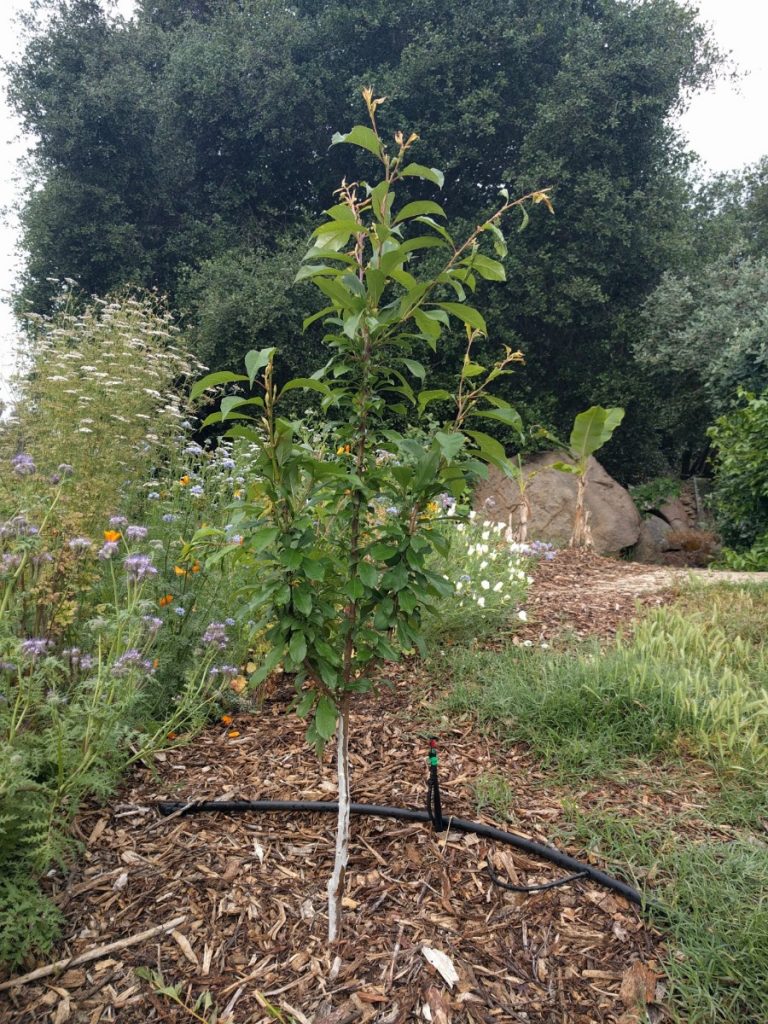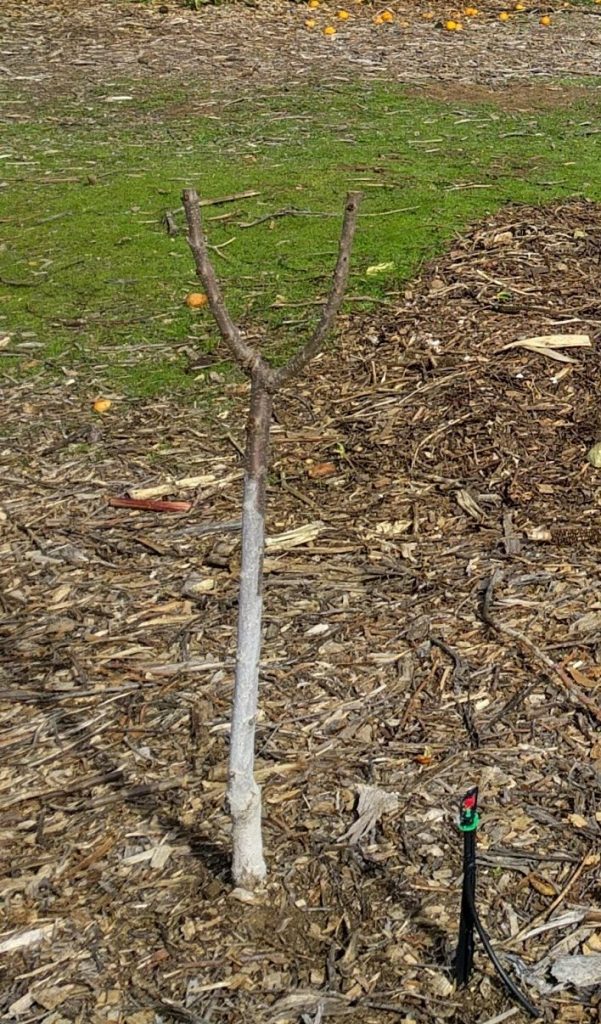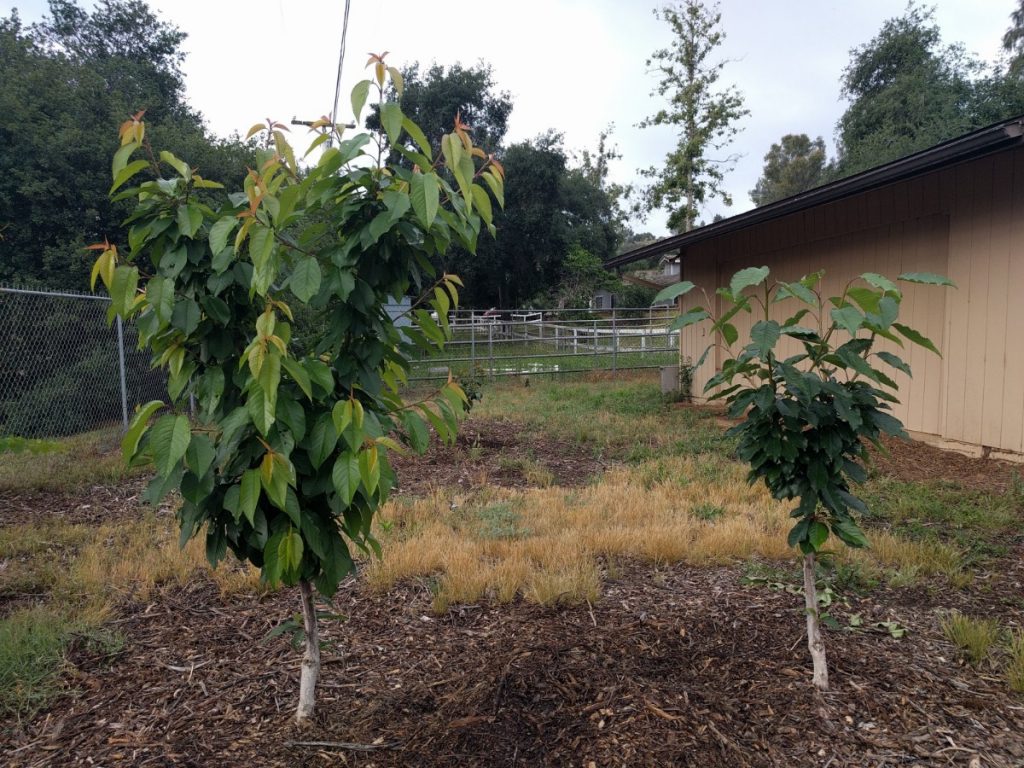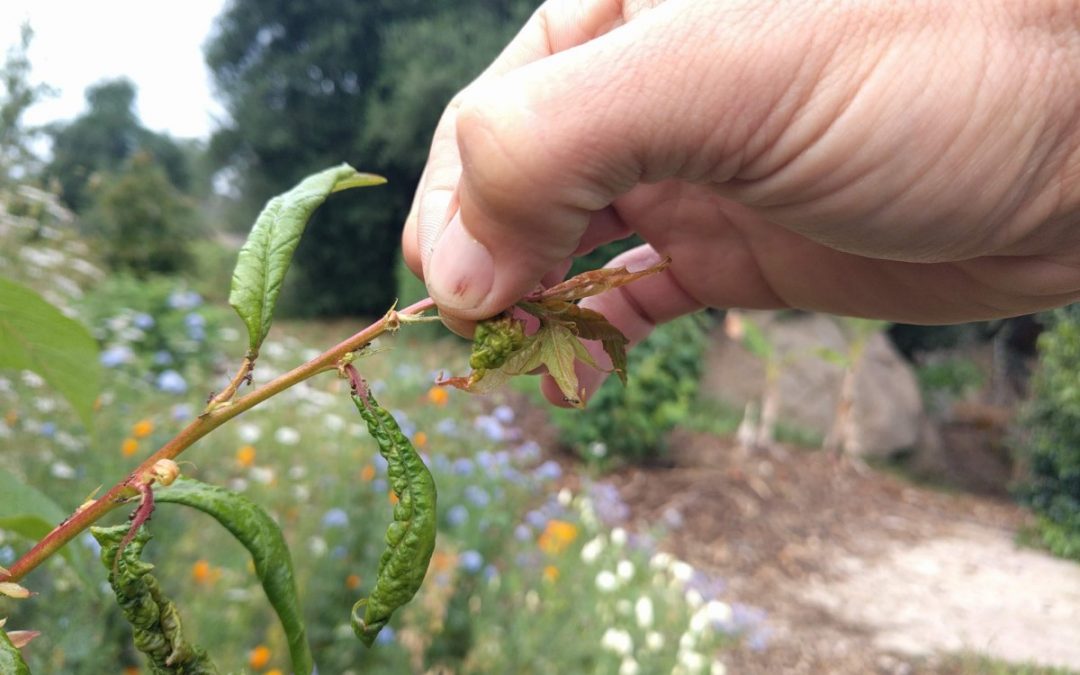Spring is for pinching. Nothing to do with Saint Patrick’s Day, this is using your fingers to prune. In the spring, trees are growing new branches that are succulent and easily snapped off by hand: no tools required.
But why pinch? And what and where to pinch? First let me show you how to do it right, and then I’ll show you how I did it wrong on one tree last year.
Why pinch?
What’s the use of pinching? The uses are many, but one of the best is in order to shape young fruit trees, especially certain kinds like apples, pears, plums, pluots, peaches, nectarines, and cherries. An example of one tree I’ve pinched over the past few weeks is this Flavor Grenade pluot:

Left alone, this tree would grow long new branches that don’t form many side branches.

I don’t want this. I want to form this tree the way I’ve formed many of my other fruit trees, which is to say, I want to keep it small. Here’s my old but small nectarine tree; this is what I’m aiming for:

An abundance of fruit within arm’s reach. For more on why you might like to keep a fruit tree small, see my post “My best advice on pruning deciduous fruit trees: Keep them small.”
How to pinch
So what I need to do is force these new spring branches to make side branches instead of just growing long and straight as they naturally would. All that requires is pinching off the tip of a new branch just above a bud, and almost immediately the tree will begin growing out the couple buds below the pinch, that is, it will make side branches, branches that grow in different directions.

I usually pinch branch tips at a distance of one to two feet from where the branch emanates from a larger branch or trunk below; at one to two feet is where I want the branch to split into side branches. The result of the pinch is often like that in the photo above: two buds grow, forming a Y shape. Sometimes, three or more buds below the pinch will grow out. Rarely, the pinch isn’t effective, and only one bud is activated.
What if I don’t pinch?
Pinching saves time. If you don’t pinch, and you let branches keep growing long and straight all spring and summer, then you’ve essentially lost a year’s time if you want to keep the tree small. This is what happened to my Royal Crimson cherry tree last year.
I somehow forgot to pinch or prune it all spring and summer last year so it grew branches about three feet long with zero side branching. This past winter I had to cut the branches back to about one foot long in order to induce side branching at that point.

As I said, missing the spring pinching opportunity (and summer pruning opportunity using shears) meant that I lost time in structuring this tree and also getting it to bear fruit as early as possible in the places that I want it to bear fruit.
In comparison, look at the size and structure of the Lapins cherry tree that I planted next to the Royal Crimson cherry tree on the same day. I planted both in January of 2018, and here they are today:

Last spring and summer, I took care to shape the Lapins cherry tree on the left, and now it is bushier and bigger and will likely bear fruit earlier at the height I desire.
This is the advantage that can be gained by pinching to shape a young tree on time. Don’t let this spring — and your young fruit trees — get away from you.
You might also like to read my other posts about pruning deciduous fruit trees:
My best advice on pruning deciduous fruit trees: Keep them small
Where to cut a branch on a deciduous fruit tree
Don’t cut off the fruiting wood: Pruning lesson number one
Think about sunshine when pruning deciduous fruit trees




Dumb question..could you please post a photo of a bud? Meaning a bud above which you’d pinch the branch. Thanks!
i just shot a video of what I did to my pluot. Pretty sure I did it right.
https://youtu.be/poudsU1Qz8k
ok after watching my own video I messed the first one up lol… supposed to pinch off the middle section and pinched an extra one off. 2nd one did correctly… going back out to fix my bad pinch.
Cool thanks! That was helpful
Should I also pinch the tips on my cherimoya and Rambutan tree starts as well?
Hi Erin,
Not a dumb question at all. In fact, my description is what is lacking. I probably should have said to pinch above a leaf.
Just above every leaf is a tiny bud — sometimes very hard to see. If you pinch just above a leaf, then you’ve pinched just above the bud that is immediately above the stem of that leaf. It’s technically called the “axillary” bud. That axillary bud will begin to grow after the pinching.
Ohh ok, thanks so much for the clarification!
I have some Yuzu seedlings about 3” to 5”. How soon or when should I first pinch them?
Tks
Hi Ric,
There’s no need to pinch them unless you want them to fork. If you do want them to fork — to branch out laterally — then I would pinch at the height where you want that to happen. The height at which they fork will remain the same for the life of the tree; in other words, the spot on the trunk where those lateral branches emanate won’t raise or lower as the tree grows taller.
If you want the trees to grow like bushes, then pinch them at around six inches off the ground. If you want them to look more like trees, then wait to pinch them at around a foot or higher off the ground.
haha perfect!! I planted a Flavor King and a 3-1 Pear tree this past winter, the sun is coming up and I’m going out to pinch them. My FKing (ok maybe I won’t use that abbrv next time) looks almost exactly like FG in the 1st picture. Looks like I’m spamming up your blogsite again.
Hi Greg,
I’d like to control the height of my avocado tree by pinching. (Yup it’s grown to over 5ft now.)
Avocado trees are capable of growing to over 20ft high and I’m wondering what would happen if I curtail the height to around 7ft.
I don’t need that much avocados a 20ft-er would provide, but I would like to be able to easily get the fruit (in maybe 5years if I’m lucky).
Thanks!
-Elaine.
Zone 9b, SF Bay Area
How soon should i pinch a peach tree seedling? I have one about 6 inches and it seem to have a lot of branches on it.
Hi Robert,
It all depends on where you want the little guy to branch. Just pinch wherever you want it to branch (fork), and it can be done any time, no matter the age of the tree.
Hello Greg! This was such a helpful article. Is it fine to pinch the leaves as soon as they emerge on the lower trunk on a young fig tree? I don’t want it to be a bush! Thank you.
How do you like the Lapins cherry?
Hi Jessie,
My Lapins tree has been satisfactory, but I really only have one other tree to compare it to, which is a Royal Crimson growing next to it. The Lapins produces more and is a slightly smaller tree.